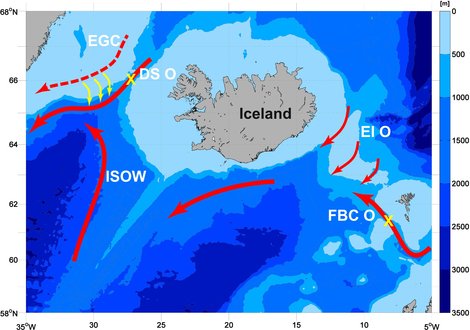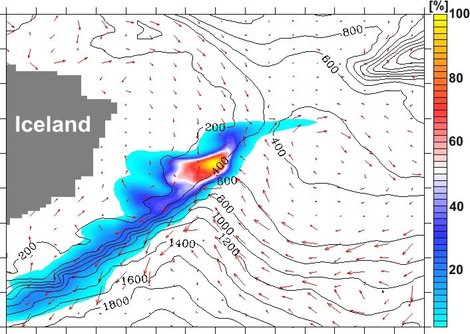Page path:
- Home
- Research
- Ocean and Climate
- Projects & Collaborative Groups
- RACE
- Theme 1
- WP 1.3: Overflow variability at the Greenland-Scotland Ridge and along the spreading pathways in the North Atlantic Ocean
WP 1.3: Overflow variability at the Greenland-Scotland Ridge and along the spreading pathways in the North Atlantic Ocean
PI:
Kerstin Jochumsen, Universität Hamburg
kerstin.jochumsen(at)uni-hamburg.de
Team:
Nuno Nunes, Universität Hamburg
Rolf Käse, Universität Hamburg
Kerstin Jochumsen, Universität Hamburg
kerstin.jochumsen(at)uni-hamburg.de
Team:
Nuno Nunes, Universität Hamburg
Rolf Käse, Universität Hamburg


Fig.1: Left panel: Schematic circulation of overflow water at the Greenland-Scotland-Ridge and further downstream in the North Atlantic Ocean. EGC: East Greenland Current; DSO: Denmark Strait Overflow; ISOW: Iceland Scotland Overflow Water; EIO: East Iceland Overflow; FBCO: Faroe Bank Channel Overflow. Yellow crosses mark the established mooring positions; yellow arrows show spilling events. Right panel: Horizontal tracer distribution obtained from the ROMS model, using a starting position for the tracer within the overflow east of Iceland. Color shows the near-bottom tracer concentration after 10 days in %, and the red arrows show the mean velocity field in the model.
The densest contribution for the formation of North Atlantic Deep Water is obtained from the dense overflowing waters, originating in the Nordic Seas and spreading into the abyssal Irminger Sea and Iceland Basin. Continuous monitoring of the two main overflow branches (e.g. in RACE I) regarding their volume and heat transport now enables us to analyze decadal variability of these properties and compare them to results from climate models. Additionally, an extended observational data set allows an improved estimate of the Denmark Strait Overflow transport, minimizing the uncertainties associated with passing mesoscale eddies.
South of the Greenland-Scotland Ridge the overflow waters are modified by entrainment of ambient water. Regarding the relevant mixing processes many questions are still unanswered: neither the contributing water masses, nor their relative contributions and variability have been sufficiently identified. In RACE II we aim at understanding and quantifying the spilling of East Greenland shelf waters, which contribute to the modification of the Denmark Strait overflow. South of the Iceland-Faroe Ridge we will carry out observations of dense water overflowing this part of the ridge, which may contribute to the Faroe Bank Channel overflow plume further downstream.
The project will provide new data from these overflow mixing regions, which are so far relatively unexplored. We will use the new observations together with idealized model experiments of float trajectories and tracer distributions to assess the sources of entrainment into the overflows and temporal variability of the involved processes.
South of the Greenland-Scotland Ridge the overflow waters are modified by entrainment of ambient water. Regarding the relevant mixing processes many questions are still unanswered: neither the contributing water masses, nor their relative contributions and variability have been sufficiently identified. In RACE II we aim at understanding and quantifying the spilling of East Greenland shelf waters, which contribute to the modification of the Denmark Strait overflow. South of the Iceland-Faroe Ridge we will carry out observations of dense water overflowing this part of the ridge, which may contribute to the Faroe Bank Channel overflow plume further downstream.
The project will provide new data from these overflow mixing regions, which are so far relatively unexplored. We will use the new observations together with idealized model experiments of float trajectories and tracer distributions to assess the sources of entrainment into the overflows and temporal variability of the involved processes.


